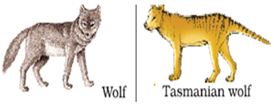Evolution - Online Test
Q1. Genetic drift
Answer : Option B
Explaination / Solution:
Genetic drift is a mechanism of evolution in which allele frequencies of a population change randomly over generations due to chance (sampling error). Genetic drift occurs in all populations of non-infinite size, but its effects are strongest in small populations.
Q2. Presence of different types of beaks in finches of Galapgos islands adapted to different feeding habits provides evidence of
Answer : Option D
Explaination / Solution:
Darwin published his intellectual bombshell, the “Origin of Species,” later in 1859. He speculated that birds, resembling starlings, came to the Galapagos Islands by wind. Evolution took over and different groups developed different diets. When, he wrote, “an immigrant first settled on one of the islands, it would undoubtedly be exposed to different conditions in the different islands (where) it would have to compete with a different set of organisms. Then, natural selection would probably favor different varieties in the different islands.”
Q3. Which of the following is the example of adaptive radiation?
Answer : Option D
Explaination / Solution:
Darwin finches and Australian marsupials are example of adaptive radiations as all the birds evolve from same birds having different beaks and Australian marsupials arise from common ancestors.
Q4. Picture shown below is example of:-


Answer : Option B
Explaination / Solution:
Wolf and Tasmania Wolf are examples of convergent evolution of placental mammals and Australian marsupials. They are evolved differently due to different in climatic and geographic regions.
Q5. Statement I: When more than one adaptive radiation appeared in isolated geographical area it called a convergent evolution.
Statement II: Bats and birds are example of adaptive radiation.
Statement III: Tiger cat, kangaroo, wombat and sugar gliders are example of Australian marsupials.
Statement II: Bats and birds are example of adaptive radiation.
Statement III: Tiger cat, kangaroo, wombat and sugar gliders are example of Australian marsupials.
Answer : Option B
Explaination / Solution:
When more than one adaptive radiation appeared in isolated geographical area it called a convergent evolution. Tiger cat, kangaroo, wombat and sugar gliders are example of Australian marsupials.
Q6. Assertion: When migration of a section of population to another occurs, gene frequencies change in the original as well as in the population.
Reason: There would be a gene flow if this gene migration happens multiple times.
Reason: There would be a gene flow if this gene migration happens multiple times.
Answer : Option C
Explaination / Solution:
gene flow (also known as gene migration) is the transfer of genetic variation from one population to another. If the rate of gene flow is high enough, then two populations are considered to have equivalent genetic diversity and therefore effectively a single population.
Q7. Human being belongs to the species of
Answer : Option A
Explaination / Solution:
Human belongs to a species of Homo sapiens, where Homo represents genus and sapiens represent specific epithet under the class Mammalia.
Q8. A baby has been born with a small tail. It is the case exhibiting
Answer : Option D
Explaination / Solution:
Avetism is the tendency to revert to ancestral type. It is a kind of evolutionary throwback, such as traits reappearing which had disappeared generation before. Baby born with small tail is a case of atavism.
Q9. Which is not a vestigial organ of man?
Answer : Option D
Explaination / Solution:
Vestigial organs are those organs which were functional in our ancestor but become functionless in present form of human beings.
Nail is not a vestigial organ of man as our fingernails are proportionately the same size as our wild counterparts, they are Not reduced structures. They still maintain their original function so they are Not atrophied or functionless.
Q10. Correct order is
Answer : Option C
Explaination / Solution:
The correct order of geological periods is Paleozoic, Mesozoic and Coenozoic. Each period have characteristic plants and animals evolved over the period of time.
